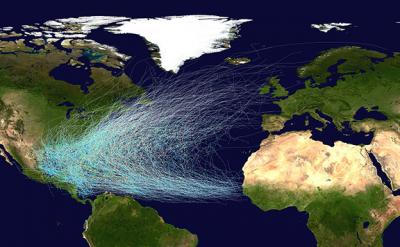Beyond Boundaries: Remote Heat Rouses Hurricanes
A shift in ocean temperature in one part of the world may have profound effects on another. Scientists at Pacific Northwest National Laboratory identified a connection between the variations in temperature of the sea surface in the North Atlantic Ocean and the Mediterranean Sea and variations in Atlantic tropical cyclones from year to year. Their research, published in Geophysical Research Letters, is the first to use 30 years of observations to systematically identify the physical and statistical linkages between the two.
Researchers at PNNL analyzed several datasets, including the track data for tropical cyclones, monthly mean sea surface temperature, and the global reanalysis of atmospheric conditions (winds, air temperature, relative humidity, precipitation and geopotential height). By compositing atmospheric conditions for years with warmer- versus colder-than-normal NAMED SST, they determined the relationship between NAMED SST and the strength of the African monsoon. The monsoon leads to subsequent changes in the African easterly jet that influences Atlantic tropical cyclone activity.
The statistical analysis quantified differences in tropical cyclone frequency in the eastern Atlantic with warm-versus-cold NAMED SST and warm-versus-cold local SST. Local wind shear and local SST are known key factors that influence the development of Atlantic tropical cyclones. By modulating multiple African monsoon processes, their results show that the NAMED SST explains comparable and approximately one-third of the interannual variability of Atlantic TC frequency as that explained by local wind shear and SST, respectively. The research found that warmer remote NAMED sea surface temperature produces an anomalous positive vorticity from West Africa extending to the main Atlantic TC development regions, shifting the African easterly jet northward, and creating an environment conducive for tropical cyclones in the Atlantic.
Hurricanes, also known as tropical cyclones, can be deadly natural hazards racking up millions of dollars in damage. Atlantic hurricanes developing mainly from the African easterly waves are responsible for about 60% of all tropical storms and weak hurricanes. They also are the reason for about 85% of the major hurricanes in the Atlantic basin. Understanding the factors that influence the year-to-year variability of Atlantic tropical cyclones may help improve predictions of hurricanes. Because the sea surface temperature (SST) in the North Atlantic Ocean and the Mediterranean Sea (NAMED) varies at longer time scales as well, these findings could improve predictions for tens to hundreds of years in the future.
This research is based on work supported by the U.S. Department of Energy, Office of Science Biological and Environmental Research as part of the Regional and Global Climate Modeling Program. The Pacific Northwest National Laboratory is operated for DOE by Battelle Memorial Institute under contract DE-AC05-76RLO1830.


